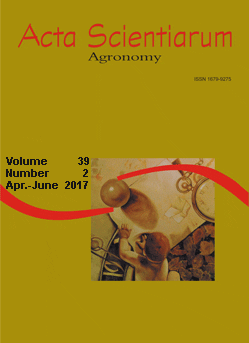Lettuce production in greenhouse under fertirrgation with nitrogen and potassium silicate
Keywords:
Lactuca sativa L., protected cultivation, micro drip irrigation, silicon.
Abstract
The objective of this study was to evaluate the effect of nitrogen and potassium silicate on the productive and commercial aspects of curly lettuce, Vera cultivar. The experimental design was completely randomized (CRD), with ten treatments and three replications. The treatments, arranged in a factorial design according to the Plan Puebla III matrix (Turrent & Laird, 1975), consisted of the combination of five doses of nitrogen (9; 54; 90; 126 and 171 kg ha-1) and five doses of potassium silicate (1.15; 6.90; 11.50; 16.10 and 21.85 kg ha-1). A control treatment without application of nitrogen and potassium silicate was also inserted. The crop was grown in a greenhouse and the doses were applied as sidedressing using drip micro-irrigation system. Total fresh matter, commercial fresh matter, non-commercial fresh matter, number of leaves and commercial trade index were evaluated. The commercial fresh matter and the number of commercial leaves per plant were affected only by nitrogen fertigation and increased linearly with the increase in the nitrogen dose of N, with the best responses observed at the highest dose of this element (171 kg ha-1). Potassium silicate had effect only in non-commercial fresh matter, not influencing the other characteristics.Downloads
Download data is not yet available.
Published
2017-04-11
How to Cite
Souza, R. S. de, Rezende, R., Hachmann, T. L., Lozano, C. S., Andrian, A. F. B. A., & Freitas, P. S. L. de. (2017). Lettuce production in greenhouse under fertirrgation with nitrogen and potassium silicate. Acta Scientiarum. Agronomy, 39(2), 211-216. https://doi.org/10.4025/actasciagron.v39i2.32897
Issue
Section
Crop Production
DECLARATION OF ORIGINALITY AND COPYRIGHTS
I Declare that current article is original and has not been submitted for publication, in part or in whole, to any other national or international journal.
The copyrights belong exclusively to the authors. Published content is licensed under Creative Commons Attribution 4.0 (CC BY 4.0) guidelines, which allows sharing (copy and distribution of the material in any medium or format) and adaptation (remix, transform, and build upon the material) for any purpose, even commercially, under the terms of attribution.
2.0
2019CiteScore
60th percentile
Powered by 

2.0
2019CiteScore
60th percentile
Powered by 



















































